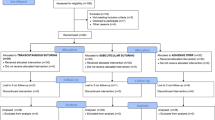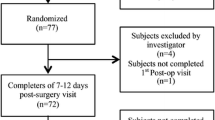Abstract
Background
Several methods for closure of trocar wounds are known in laparoscopic surgery. The choice of technique (mostly transcutaneous or subcuticular suture or adhesive papertape) is often based on the surgeon’s personal experience. Thus, the objective of this trial was to assess the impact of these closure methods on potential complications of wound healing, cosmetic outcome, and patient satisfaction.
Methods
Sixty patients undergoing operative laparoscopic surgery for gynecologic indications were enrolled in this prospective randomized trial. Five-millimeter port-site incisions were closed either with subcuticular or transcutaneous absorbable sutures (4–0 polyglactin 910) or with adhesive papertape. Postoperative complications, pain, and patient satisfaction with scars were evaluated at 3-month follow-up after operation using a questionnaire.
Results
Data from 52 patients who returned the questionnaire were analyzed. Dissatisfying cosmetic results were reported significantly more frequently after subcuticular sutures (p < 0.05). Assessment of patient satisfaction with cosmetic outcome on a visual–analogue scale revealed significantly better results after transcutaneous skin closure than with other approaches (p < 0.05). Adverse wound healing (e.g., infections and dehiscence) was observed most frequently in the subcuticular suture group. Also, the rate of painful scars was highest with this technique.
Conclusions
Transcutaneous closure with absorbable suture material seems to be the most suitable technique for closure of laparoscopic port-site incisions.
Similar content being viewed by others
References
RB Bourne H Bitar PR Andreae LM Martin JB Finlay F Marquis (1988) ArticleTitleIn- vivo comparison of four absorbable sutures: Vicryl, Dexon Plus, Max on and PDS Can J Surg 31 43–45 Occurrence Handle1:STN:280:BieC3cbhtlU%3D Occurrence Handle2827875
HH Chen WS Tsai CY Yeh JY Wang R Tang (2001) ArticleTitleProspective study comparing wounds closed with tape with sutured wounds in colorectal surgery Arch Surg 136 801–803 Occurrence Handle10.1001/archsurg.136.7.801 Occurrence Handle1:STN:280:DC%2BD3MvjvVGnsA%3D%3D Occurrence Handle11448394
GN Frishman T Schwartz JW Hogan (1997) ArticleTitleClosure of Pfannenstiel skin incision. Staples vs subcuticular suture J Reprod Med 42 627–630 Occurrence Handle1:STN:280:DyaK1c%2FhtV2ntQ%3D%3D Occurrence Handle9350017
EA Gabel GP Jimenez WH Eaglstein FA Kerdel V Falanga (2000) ArticleTitlePerformance comparison of nylon and a absorbable suture material (polyglactin 910) in the closure of punch biopsy sites Dermatol Surg 26 750–753
B Guyuron C Vaughan (1992) ArticleTitleA comparison of absorbable and nonabsorbable suture materials for skin repair Plastic Reconstr Surg 89 234–236 Occurrence Handle1:STN:280:By2C38znsFM%3D
TT Irvin (1985) ArticleTitleSimple skin closure Br J Hosp Med 33 325–330 Occurrence Handle1:STN:280:BiqB2MzksFQ%3D Occurrence Handle3893586
R Lundblad HV Simensen JN Wiig OP Niels Gruner (1989) ArticleTitleSkin closure. A prospective randomized study Tidsskr Nor Laegeforen 109 1307–1309 Occurrence Handle1:STN:280:BiaB1cvgtlQ%3D Occurrence Handle2660322
SF Matin (2003) ArticleTitleProspective randomized trial of skin adhesive versus sutures for closure of 217 laparoscopic port-site incisions J Am Coll Surg 196 845–853 Occurrence Handle10.1016/S1072-7515(03)00119-4 Occurrence Handle12788419
VM Pedersen BS Jensen B Hansen (1981) ArticleTitleSkin closure in abdominal incisions Acta Chir Scand 147 619–622
J Quinn G Wells T Sutcliffe et al. (1998) ArticleTitleTissue adhesive versus suture wound repair at 1 year: randomized clinical trial correlating early, 3-month, and 1-year cosmetic outcomes Ann Emerg Med 32 645–664 Occurrence Handle1:STN:280:DyaK1M%2FlsFCluw%3D%3D Occurrence Handle9832658
DNL Ralphs SR Cannon JP Bolton (1982) ArticleTitleSkin closure of inguinal herniorrhaphy wounds in short-stay patients Br J Surg 69 341–342
DM Rosen MA Carlton (1997) ArticleTitleSkin closure at laparoscopy J Am Assoc Gynecol Laparosc 4 347–351 Occurrence Handle1:STN:280:ByiB1MbpsFw%3D Occurrence Handle9154784
F Serour Y Efrati B Klin J Barr A Gorenstein I Vinogard (1998) ArticleTitleSubcuticular skin closure as a standard approach to emergency appendectomy in children: prospective clinical trial Word J Surg 20 38–42
RM Stillmann FJ Bella SJ Seligman (1980) ArticleTitleSkin wound closure Arch Surg 115 674–675 Occurrence Handle6246851
HR Winn JA Jane G Rodeheaver (1977) ArticleTitleInfluence of subcuticular sutures on scar formation Am J Surg 133 257–259
Author information
Authors and Affiliations
Corresponding author
Rights and permissions
About this article
Cite this article
Buchweitz, O., Wülfing, P. & Kiesel, L. A prospective randomized trial of closing laparoscopic trocar wounds by transcutaneous versus subcuticular suture or adhesive papertape. Surg Endosc 19, 148–151 (2005). https://doi.org/10.1007/s00464-004-9043-2
Received:
Accepted:
Published:
Issue Date:
DOI: https://doi.org/10.1007/s00464-004-9043-2




